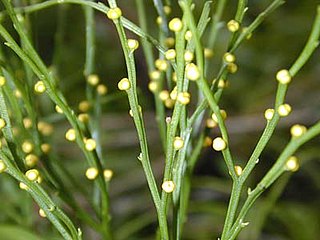
The ferns are a group of vascular plants that reproduce via spores and have neither seeds nor flowers. They differ from mosses by being vascular, i.e., having specialized tissues that conduct water and nutrients and in having life cycles in which the branched sporophyte is the dominant phase.

Diplazium esculentum, the vegetable fern, is an edible fern found throughout Asia and Oceania. It is probably the most commonly consumed fern.

The Athyriaceae are a family of terrestrial ferns in the order Polypodiales. In the Pteridophyte Phylogeny Group classification of 2016 (PPG I), the family is placed in the suborder Aspleniineae, and includes two genera. Alternatively, it may be treated as the subfamily Athyrioideae of a very broadly defined family Aspleniaceae. The family has with a cosmopolitan distribution.

Ceratopteris thalictroides is a fern species belonging to the genus Ceratopteris, one of only two genera of the subfamily Parkerioideae of the family Pteridaceae.
Serpocaulon fraxinifolium is a species of fern in the family Polypodiaceae. It is native to Mexico, Central and South America. Under the synonym Polypodium scutulatum , it was regarded as endemic to Ecuador and threatened by habitat loss.

Diplazium sibiricum, otherwise known as mole-ladder is a species of fern. It is found in Siberia, across Russia, in Finland, and in northern Asia. They can be found on elevations between 30m-3000m.

Diplazium is a genus of ferns that specifically includes the approximately 400 known species of twinsorus ferns. The Greek root is diplazein meaning double: the indusia in this genus lie on both sides of the vein. These ferns were earlier considered part of either the Athyriaceae, Dryopteridaceae, Aspleniaceae, or Polypodiaceae families or recognized as belonging to their own taxonomic family. The Pteridophyte Phylogeny Group classification of 2016 places the genus in the Athyriaceae. The taxonomy of the genus is difficult and poorly known, and by 2009 has never been the subject of a complete monographic study. Their distribution is pantropical, with a few species extending into temperate areas.

Homalosorus is a genus of fern with only one species, Homalosorus pycnocarpos. It may also be referred to by its older synonyms Athyrium pycnocarpon and Diplazium pycnocarpon. Commonly referred to as the narrow-leaved glade fern, narrow-leaved-spleenwort, or glade fern, it is endemic to eastern North America and typically grows in moist woodlands. Once classified in the family Athyriaceae due to its linear, often doubled sori, in the Pteridophyte Phylogeny Group classification of 2016, it is placed in the small family Diplaziopsidaceae, whose other three species are native to east Asia. Other sources place the genus in the subfamily Diplaziopsidoideae of a very broadly defined family Aspleniaceae, equivalent to the suborder Aspleniineae in PPG I.
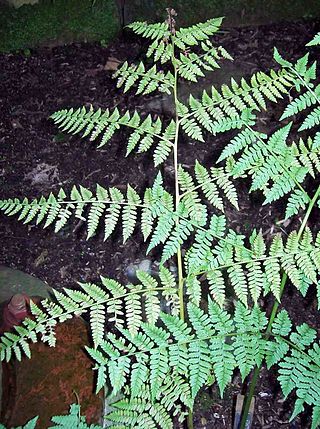
Diplazium australe, commonly known as the Austral lady fern, is a small fern occurring in eastern Australia, New Zealand and Norfolk Island. The habitat is moist shaded areas, often occurring in rainforest.
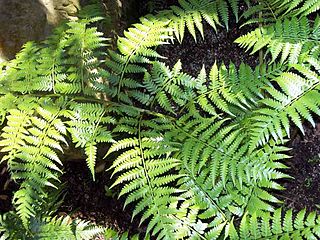
Diplazium melanochlamys is a ground fern only found on Lord Howe Island in the relatively remote Pacific Ocean between Australia and New Zealand. A common plant growing in forest. Most often seen on the southern half of the island. It can be seen between sea level and the summits of Mount Gower and Mount Lidgbird.

Diplazium molokaiense is a rare species of fern known by the common name Molokai twinsorus fern. It is endemic to Hawaii, where it is one of the rarest ferns. It has historically been found on the islands of Kauai, Oahu, Lanai, Molokai, and Maui, but it is thought to have been extirpated from four of them and today can be found only on Maui where fewer than 70 individual plants remain. The fern was federally listed as an endangered species of the United States in 1994.

Odontosoria chinensis is a fern in the family Lindsaeaceae. Commonly called lace fern, it is native from India to Hawai'i, and south to Sumatra, Borneo and the Philippines, as well as other parts of the tropics and sub-tropics. It is commonly found in forest openings and disturbed areas such as landslides, along trails or roads. It grows in moist, shady areas from sea level to an elevation of 4,000 feet.
Diplazium hymenodes, sometimes called the peacock fern, is a twinsorus fern in the wood fern family of polypod ferns. It is native to Puerto Rico, but also occurs in Jamaica and Cuba. It prefers a moist growing environment at low to low-middle elevations.

Polypodium is a genus of ferns in the family Polypodiaceae, subfamily Polypodioideae, according to the Pteridophyte Phylogeny Group classification of 2016 (PPG I). The genus is widely distributed throughout the world, with the highest species diversity in the tropics. The name is derived from Ancient Greek poly (πολύ) "many" + podion (πόδιον) "little foot", on account of the foot-like appearance of the rhizome and its branches. They are commonly called polypodies or rockcap ferns, but for many species unique vernacular names exist.
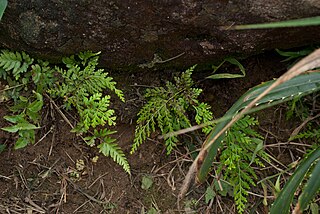
Tubho tea, is a traditional herbal tea of the Ivatan people in the Philippines made from dried leaves of the tubho fern.
Desmophlebium is a genus of ferns. In the Pteridophyte Phylogeny Group classification of 2016, it is the only genus in the family Desmophlebiaceae. Other sources place it in a more widely defined Aspleniaceae.
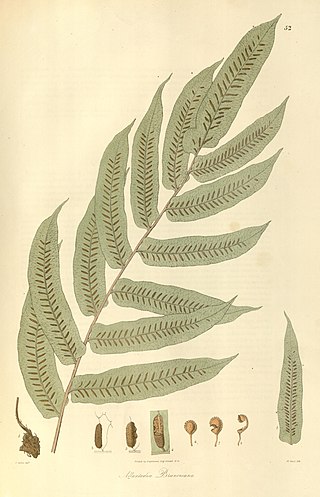
Diplaziopsis is a genus of ferns in the family Diplaziopsidaceae. The genus name means 'like Diplazium'.

Diplazium laffanianum, or Governor Laffan's fern, is a species of fern endemic to Bermuda. It is listed as extinct in the wild. It is named after Sir Robert Laffan who sent a living plant to the Royal Botanic Gardens, Kew, in 1880. The fern was found in the mouths of caves and rock crevices until 1905. 1905 was the last time Diplazium laffanianum was seen in the wild. In 2002, the spores were sent to the United States to propagate. After propagation, they were sent back to Bermuda from 2009 to 2019. In 2014, a re-introduction programme began using the zoo-raised ferns. As of 2021, there are thirty subjects of Diplazium laffanianum surviving in wild sites.

Diplazium dilatatum is a small fern occurring in India, Indochina, Malesia and Australia as far south as Wauchope, New South Wales. The habitat is moist shaded areas. The type specimen was collected from Burangrang mountain in Java.















